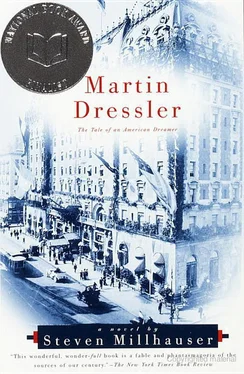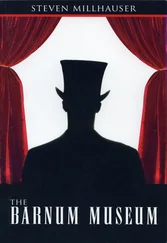After the Claire Moore episode Caroline had withdrawn to her apartment, from which she emerged only for a late breakfast in a secluded corner of the breakfast room and dinner in the main dining room with her mother and Martin and Emmeline. She refused to go shopping with her mother, refused to stroll after dinner in the courtyard, refused, despite her recent passion for the theater, to set foot in the Theater District. Margaret reported anxiously that the poor girl sat for hours over games of patience; it was bound to be bad for her back. Often when Martin returned to his rooms to dress for dinner, he would find the apartment empty: Caroline was next door, sitting in her mother’s parlor. Since Caroline was always asleep when he woke early in the morning, and asleep when he went up to his bed late at night, it struck Martin that he saw her only at dinner, when she seemed faded and tired, as if she had been pulled with difficulty out of the thick, sticky sleep surrounding her on both sides of dinner, an ooze of sleep into which she would be sucked the moment she put down her fork; and as he glanced at her shadowy form in the bed at night, or her pale face staring at the brilliant white cloth of the dinner table, it seemed to him that she was gradually dissolving, like the sugar cubes he had liked to drop long ago into a glass of water and watch until there was nothing left but a slightly cloudy liquid.
Martin meanwhile had begun to spend more time away from the Dressler, for he wanted to follow closely every detail of the construction of the new building. He watched the drilling of blast holes in boulders, the arrival of the first steel beams and columns on flatbed trucks pulled by teams of big truck-horses, the making of the plank-and-steel retaining walls, the lifting of the steel by towering steam cranes, floor by subterranean floor; and as the first columns rose over the top of the excavation, Martin had the sudden sharp sense of the bones of his shoulders pressing upward against his skin.
Sometimes he seemed to hear, all up and down the West End, a great ripping or breaking, as bedrock split open to give birth to buildings. Along the Boulevard, on Amsterdam and Columbus, on lots facing the Central Park, on side streets between Sixtieth and 110th, hoardings seemed to spring up overnight. Many of the new buildings were small apartment houses under seven stories, which the housing laws did not require to be fireproofed, but ten-story and twelve-story apartment houses were also going up, and here and there a builder of hotels aspired to something grander, something that rang out like a bell. From the roof garden of the Dressler Martin looked down at a world of open pits and blasted rock, of half-finished apartments prickly with scaffolding, of steam cranes slashing their black diagonals across brownstone and brick. It was as if the West End had been raked over by a gigantic harrow and planted with seeds of steel and stone; now as the century turned, the avenues had begun to erupt in strange, immense growths: modern flowers with veins of steel, bursting out of bedrock. The rash of building had its own clear logic, based on the coming subway, just as the downtown construction of higher and higher office buildings was a direct result of the soaring cost of city real estate and the invention of the electric elevator — but Martin, looking down from the roof garden of the Dressler, wondered whether all such explanations were nothing but clever disguises meant to conceal a secret force. For what struck him was the terrible restlessness of the city, its desire to overthrow itself, to smash itself to bits and burst into new forms. The city was a fever-patient in a hospital, thrashing in its sleep, erupting in modern dreams. His own dream was to push the New Dressler beyond the limits of the old, to express in a single building what the city was expressing separately in its hotels and skyscrapers and department stores; and again he had the old dream-sense that friendly powers were leading him along, powers sympathetic to his deepest desires.
The New Dressler opened on August 31, 1902, on Martin’s thirtieth birthday. The twenty-four-story building, with its seven underground levels and a massive basement, was advertised as the largest family hotel in the world, a claim immediately attacked by a journalist in the Sun , who asked whether it could properly be called a hotel at all. Harwinton, who had foreseen the question and secretly encouraged it, promptly flooded the city with mystery posters reading: MORE THAN A HOTEL: A WAY OF LIFE. The critics were divided over certain features, such as the three-story entrance arch decorated with twenty-four statues of American historical and cultural figures, including Abraham Lincoln, Thomas Edison, Pocahontas, Henry Wadsworth Longfellow, Elisha Graves Otis, Washington Roebling, James Fenimore Cooper, and William Le Baron Jenney, or the arched bridges spanning the exterior courts at the level of the twelfth floor, or the profusion of ornamentation, from the small terra-cotta scenes representing American Industry on the Gothic window surrounds to the bands of painted tiles running along the base of each wrought-iron balcony and representing New York scenes both historical and contemporary, such as the director of the Dutch West India Company purchasing the isle of the Manhattoes from an Indian with one feather on his head, Washington Roebling seated at his window in Brooklyn Heights looking out at the Manhattan tower of the great bridge, and a procession of trotting rigs on a drive in the Central Park. What struck reporters most sharply, however, was the inside of the New Dressler — the secret hotel, in the phrase of one writer. Much attention was drawn by the seven underground levels, composed of a landscaped park with real squirrels and chipmunks (the first level), a complete department store (the second, third, and fourth levels), a series of Vacation Retreats (the fifth and sixth levels), and a labyrinth (the seventh level). The Vacation Retreats of the fifth and sixth levels received the most elaborate comment, for it was here that Rudolf Arling, drawing on his early days in the theater, had designed a series of six vacation spots for the use of hotel guests: a campground with tents in a brilliantly reproduced pine forest with swift-flowing streams; the deck of a transatlantic steamer, with canvas deck chairs, shuffleboard courts, and hand-tinted films of ocean scenery displayed on the walls; a wooded island with log cabins in a large lake with a ferry; a replication of the Atlantic City boardwalk, complete with roller-chair rides, as well as half a dozen streets crowded with theaters and movie houses; a health spa with mineral baths; and a national park containing a geyser, a waterfall, a glacier, a small canyon, and winding nature trails. Harwinton’s ads proclaimed:
A ROOM WITH VACATION,
BEST DEAL IN THE NATION
and critics were quick to point out that a visit to a cleverly reproduced landscape underneath a hotel hardly counted as a vacation, although one reporter, after catching a trout in a campground stream and cooking it over a fire outside his tent, argued that the vacations offered by the New Dressler were superior to so-called “real” vacations, since the Dressler vacation spots cost practically nothing (there were small charges for renting a canoe on the island lake, collecting firewood in the campground, having a drink in the bar of the transatlantic steamer, and so on), could be reached almost immediately and without the inconvenience and irritation of long railway journeys, and, above all, could be temporarily abandoned at night for a sound sleep in the comfort of one’s own familiar bed.
But if the fifth and sixth underground levels of the New Dressler attracted strong notice, an equal amount of attention was directed at the twelfth floor, with its series of four arched bridges over the four exterior courts. For here Rudolf Arling, following Martin’s careful instructions, had interrupted the pattern of apartments to devote the entire floor to what was called the Museum of Exotic Places — a series of scrupulously designed reproductions of such places as an Eskimo village, a Scottish glen, the Tuileries Gardens, the canals of Venice (with real water and gondolas), an archaeological dig in the Tigris-Euphrates valley, Shakespeare’s birthplace, and the Amazon jungle, each lit by colored stage lights and inhabited by actors in authentic costumes, so that the visitor had the double sensation of entering an actual place and enjoying a clever artistic effect.
Читать дальше












